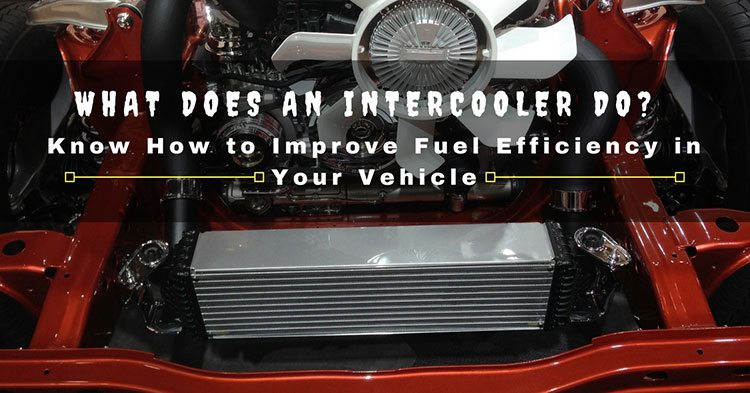
What Does an Intercooler Do? Know How to Improve Fuel Efficiency in Your Vehicle
Since the advent of supercharged and turbocharged engines intercoolers have become an important part of car engines. Are you wondering, ‘What does an intercooler do?’ The intercooler, as the name suggests, is a cooling device that cools intake air in turbocharged engines.
More...
Turbocharger or supercharger in an engine compresses air that passes to the car engine. The intercooler serves as an intermediate cooling agent,ensuring the air supply to engine is of higher density.
What Does an Intercooler Do?

Photo by Steven Benes
The main role of an intercooler is to reduce the temperature of the air entering the engine from the turbocharger. To understand the influence of intercooler, you have to know why it is needed.
The turbocharger is included mainly because of the powerful engine performance it elicits. However the compressed air from the turbocharger becomes too hot quickly. This causes oxygen content to drop fast resulting in excess fuel burned than necessary for powering the engine.
Cool air has higher density and hence provides air rich in oxygen. This makes the engine to burn more of fuel. As a result, you will find improved combustion and more power.
The intercooler also makes the performance of the engine reliable, because it helps provide intake air of consistent and cooler temperature. With the engine receiving cool air, the ratio of air and fuel inside the engine is maintained at a balanced and safe level.

Types of Intercoolers
Now that you know about intercoolers and their role in engine performance, let us see about different types of intercoolers present. There are basically two types:
- Air to Air
- Air to Water
Air to Air
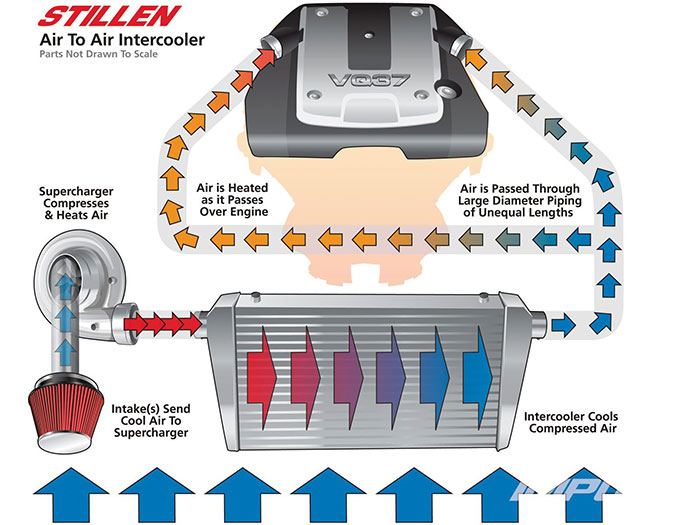
Image Source: Superstreet online
Air to Air type of intercooler consists of a tube network through which air in compressed form is passed from the turbocharger. The intercooler‘s role is to cool the hot compressed air entering into it.
Once the air enters into the intercooler it dissipates the heat by directing it to the tubes and then to cooling fins. Cool air present outside and at very high traveling speed sucks up the heat from cooling fins. This reduces the high temperature present in the compressed intake air.
Why is this System Popular?
- It is simple in design
- Light in weight
- Cost is lower
On the other hand, it is not the right choice because
- It has longer intake length
- Temperature variation is more
Air to Water
This type of intercooler uses water as the medium for heat transfer. Cool water enters the intercooler and removes heat from compressed air, while it passes through the intercooler.
The water which is now heated is pumped via another circuit for cooling it, which is mostly a radiator dedicated to cooling it. This is different from the radiator that cools the hot air exiting from the engine via a thermostat. Meanwhile the compress air passes on to the car engine powering it.
How are the two intercoolers different? The air to water type is smaller and hence suitable for setups where the airflow, intake length and space cause difficulties.
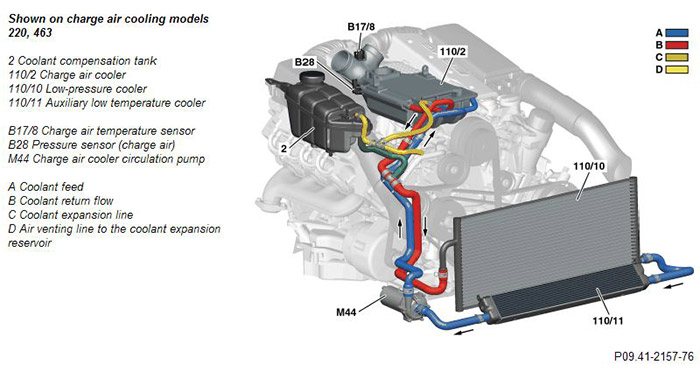
Image source: mbworld.org
Also called as heat exchangers, these devices are more efficient than the air to air models. Stability is more, enabling the devices to manage a wider temperature range.
However the heat exchangers have their own downsides. They are too heavy and complex. And you have to shell out more money for the radiator, transfer lines, water and pump. Due to this reason such intercoolers are used mostly in marine and industrial machinery, and in rear engine cars where air to air type of intercooler instalment is not possible.
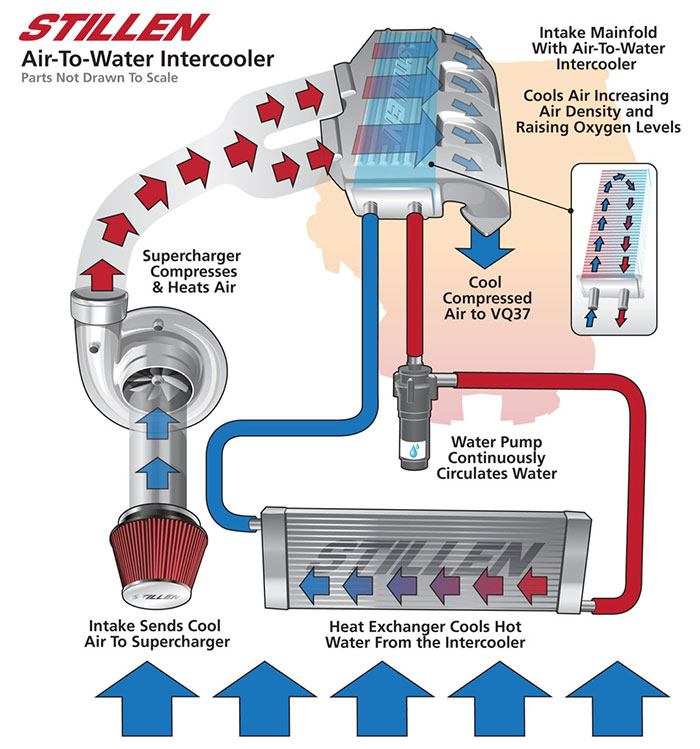
Source: Engine Basics
Installation of Intercoolers
The front portion of a vehicle is the ideal setup for the air to air type of intercooler. This front mount is definitely the placement that is most effective. If the engine structure or the vehicle model does not allow a front mounted intercooler, it can be mounted over an engine or on its sides.
However such placement is not good for the engine as there is insufficient air flow. And with drop in external air flow, heat soak trickling from engine can damage the intercooler. To avoid such an issue additional air duct placements or scoops will be needed to direct the air straight into the vehicle’s intercooler.
On the contrary, air to water system can be mounted in any part of engine bay provided you mount the radiator in an area where there is sufficient air flow or has an attached thermo fan to cool it.
Faults that Occur with Intercooler
Here are three most common issues you can face with an intercooler and the ways to deal with them:
1. Leak in the Boost Hoses

Image source: golfmk6.com
Intercooler is the least trouble causing part in the engine. If you do get faults they are mostly linked with defective installation or physical damage to the intercooler that cause the boost hoses to leak.
The boost hose made of rubber and clamps that hold it in place are the most commonly affected parts. The rubber can wear away with time causing the clamps holding it to loosen. This results in leak of boosted air through the hose.
With air leak, the engine performance is affected greatly. You can even hear an audible whooshing sound sometimes when the air leaks while driving.
The Solution:
Replacing the clamps and hoses will easily take care of this issue.
2. Impact Damage
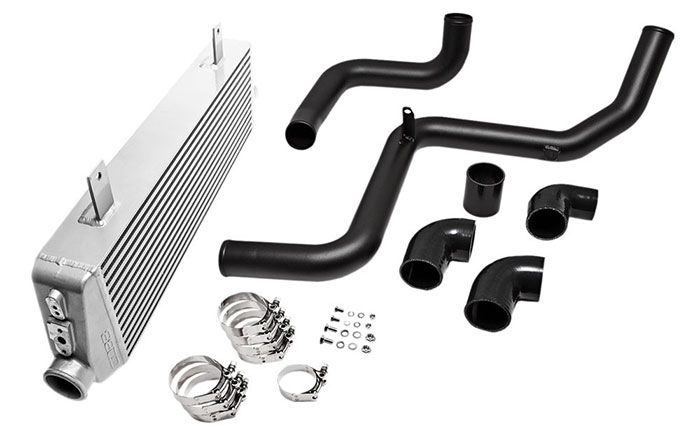
Source: CJPony Parts
In case of a front mounted intercooler, there is more risk of damage from debris and stones striking the intercooler while driving.
The cooling fins, which are of delicate build, are easily damaged. This will affect the cooling capacity and even damage tubes that carry the powered air to the engine.
The Solution:
As in the first issue, there is reduced performance of the intercooler and higher air temperatures at the inlet. In severe cases, the air may start to leak too. In this case you have to replace the entire intercooler.
3. Oil Contamination
If there is some issue with the turbocharger, it affects the intercooler too. For instance, if there is oil leak in the turbocharger because of worn out seals, the leaked oil will pass to the intercoolerand settles at the bottom. This reduces intercooler performance and the oil vapours are passed to the cooled air resulting in reduced engine performance.
The Solution:
To deal with this issue, you have to remove boost hoses and look for any signs of contamination with oil. Flush out the intercooler with an engine degreaser. This will take care of the issue effectively.
Conclusion!
We hope our explanation provides a clear idea to your question of, ‘What does an intercooler do?’ With our simple trouble shooting steps you will be able to detect any fault in the intercooler and improve your engine performance. And if you are looking for an upgrade of your intercooler, our guide is sure to help you choose the best one.
Remember that for intercoolers to perform well construction is very important. With the appropriate upgrades, you can easily bring about improvement in the way the engine burns fuel and save you plenty of money and effort. If you like this topic and want to share your thoughts and comments fell free to post them here. And please share this article on all social media platforms.
Related Posts
Top Simple Ways to Improve the Look of Your Car
What are toll roads, and how to pay the tolls?
How to Increase Your Visibility When Driving at Night
How To Add Coolant To Car? Learn How To Boost Engine Performance And Efficiency
The Best Synthetic Oil You Can Consider in your Next Scheduled Car Service

